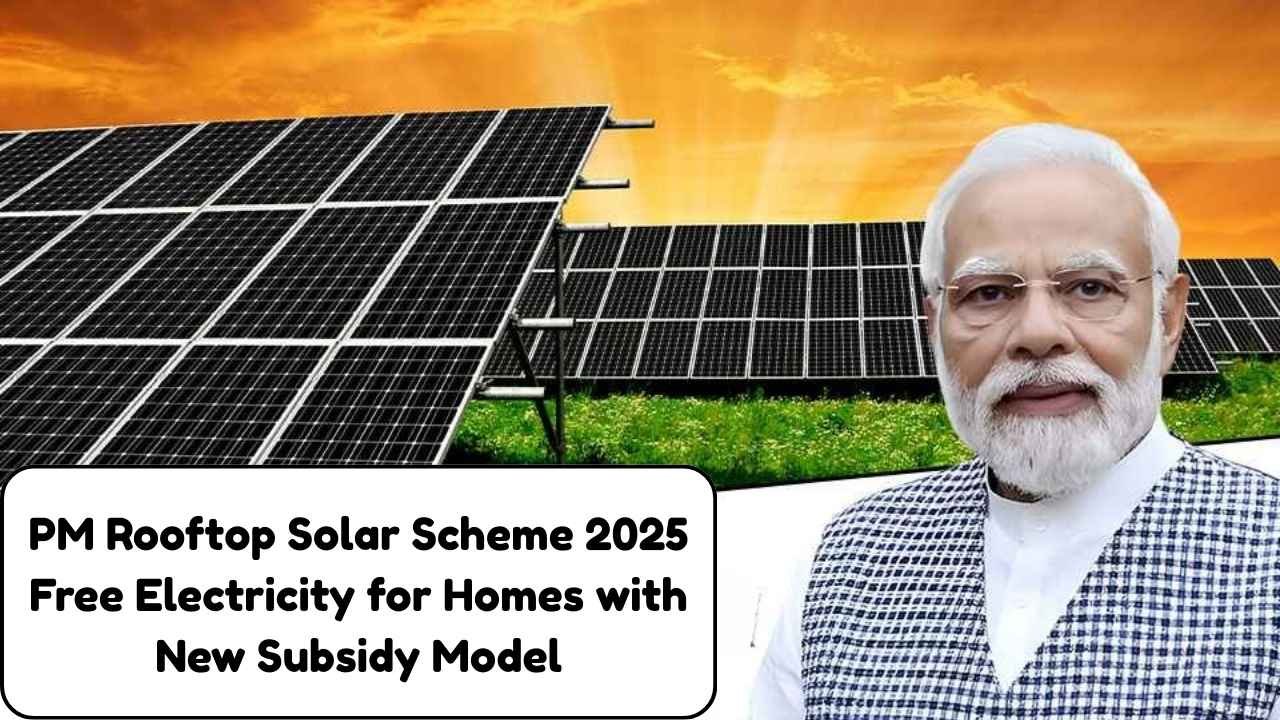The Government of India has consistently worked towards making the country self-reliant in energy while also reducing the burden of rising electricity costs on households. In 2025, the Prime Minister’s Rooftop Solar Scheme has been unveiled with a new subsidy model that aims to provide free electricity for homes across the nation. This scheme is expected to encourage the widespread adoption of solar energy, reduce dependency on conventional power sources, and support India’s commitment towards clean and green energy.
What is the PM Rooftop Solar Scheme 2025
The PM Rooftop Solar Scheme 2025 is a government initiative to install solar panels on residential rooftops and provide financial subsidies to households, making solar power more affordable. The scheme promotes the concept of generating electricity directly from sunlight, enabling families to reduce or even eliminate their monthly electricity bills. With the new subsidy model, a large portion of the installation cost will be borne by the government, ensuring that even middle-class and lower-income families can adopt this technology without worrying about high upfront expenses.
The ultimate goal of the scheme is to provide free electricity to millions of homes across India while simultaneously cutting down on the nation’s carbon footprint.
Why the Scheme is Important in 2025
With electricity demand rising every year, households are facing increasing power costs. At the same time, India is also working to reduce its reliance on fossil fuels and meet global climate commitments. The rooftop solar scheme addresses both these challenges. For families, it means relief from high electricity bills, while for the nation, it represents a major step towards renewable energy goals.
In 2025, as inflation and energy demand grow, solar energy has emerged as the most sustainable solution. By promoting rooftop solar panels at the household level, the government is creating a decentralized model of power generation that benefits both the people and the environment.
New Subsidy Model Explained
The most attractive feature of the PM Rooftop Solar Scheme 2025 is the revised subsidy structure. Under the new model, the government will cover a significant percentage of the installation cost, making solar panels accessible to households across different income groups. Families that generate surplus power from their rooftop panels can also sell the excess electricity back to the grid, creating an additional source of income.
For example, a household that consumes a moderate amount of electricity can install panels with government support at a fraction of the cost. Once installed, the family enjoys free power for years, and any excess energy generated is credited to their electricity account or directly paid by the power distribution company.
How Households Benefit from the Scheme
The benefits for households under the rooftop solar scheme are both immediate and long-term. Families save money every month by drastically reducing or completely eliminating their electricity bills. With rising energy costs, this saving becomes more valuable year after year. Over time, the panels generate enough electricity not only for home use but also for sharing with the grid, making families energy self-sufficient.
Another important benefit is energy security. Power cuts and supply shortages are common issues in many parts of India, especially rural and semi-urban areas. With rooftop solar panels, households can enjoy uninterrupted electricity as long as there is sunlight. This adds comfort, reliability, and independence to their daily lives.
Impact on Environment and Economy
The scheme is not only about free electricity but also about creating a cleaner environment. By reducing dependency on coal and other fossil fuels, rooftop solar installations help cut carbon emissions and air pollution. This is a major contribution to India’s climate action goals.
Economically, the scheme is expected to create thousands of jobs in the solar manufacturing, installation, and maintenance sectors. As demand for solar panels increases, domestic manufacturing will also receive a boost under the government’s Make in India initiative. This creates a positive cycle of growth, employment, and sustainability.
How to Apply for the Scheme
Applying for the PM Rooftop Solar Scheme 2025 has been made simple and transparent. Homeowners can visit the official portal dedicated to the scheme and submit their applications online. The process involves providing basic details about the household, rooftop size, and electricity usage. Once the application is verified, authorized solar installation companies will carry out the setup at subsidized rates.
The government has ensured that the process remains free of middlemen, with direct subsidies transferred to households or adjusted against installation costs. This approach not only builds trust but also ensures that the benefits of the scheme reach the right people without delay.
Early Response and Expectations
Initial reports suggest that the scheme has already attracted widespread interest from urban as well as rural households. Families struggling with high electricity bills see it as an opportunity for permanent relief, while environmentally conscious citizens view it as their contribution to a greener India. The government expects that millions of households will adopt solar energy in the coming years, making India one of the leaders in residential solar power adoption.
Experts also believe that as technology improves and panel efficiency increases, the returns from such installations will grow further. Combined with the subsidy, the payback period for households is expected to be shorter, making the scheme even more appealing.
Challenges in Implementation
Like every major program, the rooftop solar scheme may face challenges. Awareness among rural families remains a hurdle, as many are still unfamiliar with solar technology. Maintenance of solar panels and ensuring proper after-sales support are other areas that need attention. However, with government monitoring and the involvement of certified installation agencies, these challenges can be managed effectively.
Conclusion
The PM Rooftop Solar Scheme 2025 is more than just an energy-saving initiative; it is a transformative program that empowers households with free electricity and financial independence. By introducing a new subsidy model, the government has made solar energy accessible to millions of Indian families. The scheme not only provides immediate relief from electricity bills but also contributes to the larger goals of clean energy, environmental protection, and job creation. For households, it is an opportunity to achieve energy self-sufficiency, and for the nation, it is a step forward in building a sustainable future.
Disclaimer
The information provided in this article is based on the government’s announcement of the PM Rooftop Solar Scheme 2025. Actual subsidy amounts, eligibility criteria, and application details may vary, and applicants are advised to refer to official government notifications for the latest updates.
FAQs
Q1. What is the PM Rooftop Solar Scheme 2025?
It is a government initiative that provides subsidies to install solar panels on rooftops, helping households generate free electricity.
Q2. How does the new subsidy model work?
The government covers a large portion of the installation cost, making solar energy affordable for families across different income groups.
Q3. Can households earn money from this scheme?
Yes, if households generate excess power, they can sell it back to the grid and earn credits or payments.
Q4. Who can apply for the scheme?
Any homeowner with suitable rooftop space can apply for the scheme through the official government portal.
Q5. What are the benefits of rooftop solar panels?
They reduce or eliminate electricity bills, provide energy security, and contribute to a cleaner environment.



